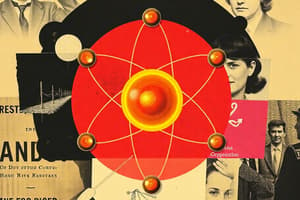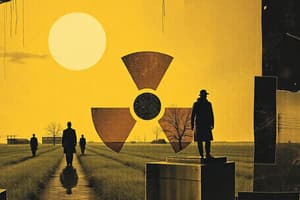Podcast
Questions and Answers
What is carbon-14 primarily used for?
What is carbon-14 primarily used for?
- Creating nuclear power
- Dating archaeological samples (correct)
- Medical imaging
- Inventing new elements
Which process involves the splitting of a heavy nucleus into lighter nuclei?
Which process involves the splitting of a heavy nucleus into lighter nuclei?
- Nuclear fusion
- Alpha decay
- Beta decay
- Nuclear fission (correct)
Who developed the nuclear model of the atom?
Who developed the nuclear model of the atom?
- Niels Bohr
- Marie Curie
- Albert Einstein
- Ernest Rutherford (correct)
What subatomic particle is emitted during beta-minus decay?
What subatomic particle is emitted during beta-minus decay?
Which force is responsible for binding protons and neutrons together in the nucleus?
Which force is responsible for binding protons and neutrons together in the nucleus?
What primarily determines the identity of an element?
What primarily determines the identity of an element?
What is the primary force that holds protons and neutrons together in the nucleus?
What is the primary force that holds protons and neutrons together in the nucleus?
Which term describes variants of the same element with different numbers of neutrons?
Which term describes variants of the same element with different numbers of neutrons?
How is the mass number of an atom calculated?
How is the mass number of an atom calculated?
Which particle in the atomic nucleus has a positive charge?
Which particle in the atomic nucleus has a positive charge?
What does the atomic number represent in an atom?
What does the atomic number represent in an atom?
How are elements organized on the periodic table?
How are elements organized on the periodic table?
What is the formula used to calculate mass number?
What is the formula used to calculate mass number?
Which statement about isotopes is correct?
Which statement about isotopes is correct?
How can you determine the number of neutrons in an atom?
How can you determine the number of neutrons in an atom?
What atomic number does oxygen have?
What atomic number does oxygen have?
Which of the following represents a correct relationship between atomic mass and isotopes?
Which of the following represents a correct relationship between atomic mass and isotopes?
Why is the balance between protons and neutrons important for an atom?
Why is the balance between protons and neutrons important for an atom?
What defines the identity of an element?
What defines the identity of an element?
Which of the following is an example of an isotope?
Which of the following is an example of an isotope?
What determines the atomic number of an element?
What determines the atomic number of an element?
Which statement best describes neutrons in the atomic nucleus?
Which statement best describes neutrons in the atomic nucleus?
What is the mass number of an atom with 8 protons and 6 neutrons?
What is the mass number of an atom with 8 protons and 6 neutrons?
Which property is used to distinguish isotopes of the same element?
Which property is used to distinguish isotopes of the same element?
How does the strong nuclear force impact the stability of an atomic nucleus?
How does the strong nuclear force impact the stability of an atomic nucleus?
What occurs during nuclear fission?
What occurs during nuclear fission?
Which statement accurately describes the Bohr model of the atom?
Which statement accurately describes the Bohr model of the atom?
How is gamma decay best characterized?
How is gamma decay best characterized?
Which application of isotopes is NOT mentioned in the context provided?
Which application of isotopes is NOT mentioned in the context provided?
What is the role of gluons in the nucleus?
What is the role of gluons in the nucleus?
Flashcards are hidden until you start studying
Study Notes
Isotopes
- Isotopes are atoms of the same element with varying numbers of neutrons.
- This variation affects their atomic mass but not their atomic number.
- Isotopes have the same chemical properties but can differ in physical properties.
Types of Isotopes
- Stable isotopes do not undergo radioactive decay.
- Examples: Carbon-12 (¹²C) and Oxygen-16 (¹⁶O)
- Radioactive isotopes (radioisotopes) are unstable and emit radiation.
- Examples: Carbon-14 (¹⁴C) and Iodine-131 (¹³¹I)
Isotope Representation
- Isotopes are represented using the element symbol followed by the mass number.
- Example: Carbon-12 is represented as ¹²C.
Isotopic Abundance
- Elements often exist as a mixture of isotopes with varying abundance.
- The atomic mass of an element represents the weighted average of its isotopes and their abundance.
Applications of Isotopes
- Medicine: Diagnostic imaging (e.g., Technetium-99m), radiotherapy (e.g., Iodine-131)
- Environmental Science: Tracer studies, pollution analysis
- Archaeology and Geology: Radiocarbon dating, stable isotope geochemistry
- Industry: Nuclear power, tracer studies for process analysis
- Other: Used in dating methods, studying historical events, and tracing the origin of materials.
Isotopes and their Role in Science
- Isotopes are variations of the same element that have different numbers of neutrons.
- This difference in neutron count leads to different atomic masses.
- Isotopes are fundamental to furthering our understanding of atomic and molecular processes.
Isotopes in Nuclear Physics
- Studying isotopes helps scientists understand nuclear reactions and how stable isotopes are.
- Isotopes also provide information about the forces that bind protons and neutrons together within the nucleus.
Isotopes in Quantum Mechanics
- Isotopes offer insights into quantum mechanical models of the nucleus and atomic behavior, contributing to our understanding of atomic structure and reactions.
Isotope Production
- Some isotopes occur naturally, while many others are produced artificially.
- Artificial production methods include nuclear reactors and particle accelerators.
- For example, technetium-99m is produced by irradiating molybdenum-98 ( 98 M o 98Mo).
Handling Isotopes
- Processing and handling radioactive isotopes require strict safety measures to protect against radiation exposure.
- These safety measures include proper storage, shielding, and disposal procedures.
- These measures are essential for minimizing health risks and environmental impact.
Conclusion
- Isotopes can be stable or radioactive and find diverse applications in medicine, industry, environmental science, and archaeology.
- Understanding isotopes is a crucial concept across many fields, as they provide valuable insights into atomic structure, nuclear processes, and applications.
Isotopes and Their Significance
- Isotopes are atoms of the same element that have the same number of protons but different numbers of neutrons.
- Atomic Number (Z): The number of protons in an atom's nucleus, defining the element.
- Mass Number (A): The total number of protons and neutrons in the nucleus, used to identify isotopes.
- Stable Isotopes do not undergo radioactive decay.
- Examples include carbon-12 (¹²C) and oxygen-16 (¹⁶O).
- Radioactive Isotopes (Radioisotopes) are unstable and decay over time, emitting radiation.
- Examples include carbon-14 (¹⁴C) and iodine-131 (¹³¹I).
- Isotope Representation: Uses the element symbol followed by the mass number (e.g., ¹²C for carbon-12).
- Isotopic Abundance: Elements exist as a mixture of isotopes in varying amounts.
- Atomic Mass Calculation: The weighted average of the masses of all isotopes of an element, considering their abundance.
- Applications of Isotopes: Found across various fields, including:
- Medicine: Diagnostic imaging with technetium-99m (⁹⁹mTc), radiotherapy with iodine-131 (¹³¹I).
- Environmental Science: Tracer studies with nitrogen and carbon isotopes, pollution analysis with sulfur and nitrogen isotopes.
- Archaeology and Geology: Radiocarbon dating with carbon-14 (¹⁴C), stable isotope geochemistry with oxygen, hydrogen, and strontium isotopes.
- Industry: Nuclear power with uranium-235 (²³⁵U), radiotracers for process analysis and detection.
What are Isotopes?
- Isotopes are variations of the same element with different numbers of neutrons. This leads to different atomic masses.
- For example, carbon-12 and carbon-14 are isotopes of carbon.
The Importance of Isotopes
- Isotopes are crucial for advancing our understanding of atomic and molecular processes.
- They play a vital role in nuclear physics, quantum mechanics and various fields.
Nuclear Physics
- Studying isotopes helps scientists understand nuclear reactions, like fusion and fission.
- Isotopes help us understand nuclear stability, including why some isotopes are radioactive.
- They help us comprehend the forces that bind protons and neutrons together in the nucleus of an atom.
Quantum Mechanics
- Isotopes provide valuable insights into quantum mechanics, including models of the nucleus and atomic behavior.
- This helps us understand the structure of atoms and how they react.
How are isotopes produced?
- Some isotopes occur naturally.
- Many isotopes are produced artificially in nuclear reactors or particle accelerators.
- For example, technetium-99m is produced by irradiating molybdenum-98.
Safety and Handling
- Radioactive isotopes require specific safety measures due to the risk of radiation exposure.
- Proper storage, shielding, and disposal are essential.
Application of Isotopes
- Isotopes have diverse applications across medicine, industry, environmental science, and archaeology.
- For example, radioactive isotopes are used in medical imaging and radiation therapy. They can also be used to date ancient artifacts, understand climate change, and track pollution.
Studying That Suits You
Use AI to generate personalized quizzes and flashcards to suit your learning preferences.




